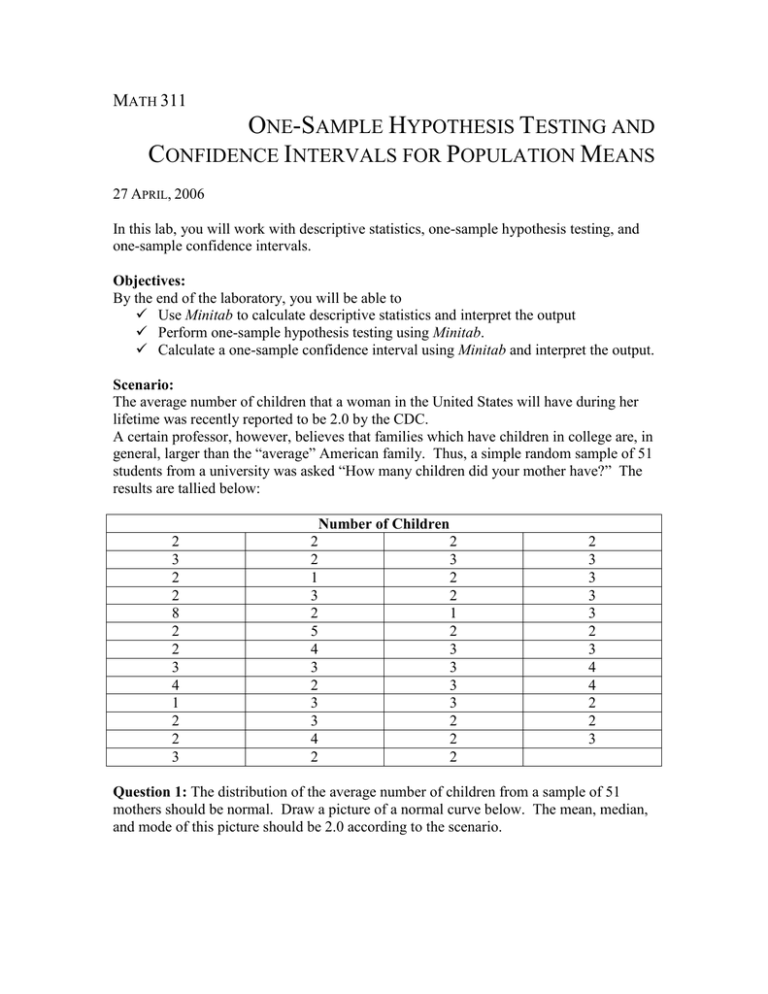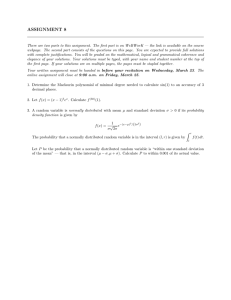O -S H T
advertisement

MATH 311 ONE-SAMPLE HYPOTHESIS TESTING AND CONFIDENCE INTERVALS FOR POPULATION MEANS 27 APRIL, 2006 In this lab, you will work with descriptive statistics, one-sample hypothesis testing, and one-sample confidence intervals. Objectives: By the end of the laboratory, you will be able to Use Minitab to calculate descriptive statistics and interpret the output Perform one-sample hypothesis testing using Minitab. Calculate a one-sample confidence interval using Minitab and interpret the output. Scenario: The average number of children that a woman in the United States will have during her lifetime was recently reported to be 2.0 by the CDC. A certain professor, however, believes that families which have children in college are, in general, larger than the “average” American family. Thus, a simple random sample of 51 students from a university was asked “How many children did your mother have?” The results are tallied below: Number of Children 2 3 2 2 8 2 2 3 4 1 2 2 3 2 2 1 3 2 5 4 3 2 3 3 4 2 2 3 2 2 1 2 3 3 3 3 2 2 2 2 3 3 3 3 2 3 4 4 2 2 3 Question 1: The distribution of the average number of children from a sample of 51 mothers should be normal. Draw a picture of a normal curve below. The mean, median, and mode of this picture should be 2.0 according to the scenario. Question 2: How do you think our data should relate to the national average? Use a complete sentence to write your hypothesis. Hint: we have no reason to believe our data will be any different from the national average. Question 3: Formulate the null and alternative hypotheses we’ll use to test the professor’s belief. Clearly define the parameter being tested (i.e. state what μ represents). Let μ = H0: μ = HA: μ Now enter the data above into a Minitab worksheet. Label the column “Children.” Question 4: Run the descriptive statistics on the number of children in our sample. Fill in the blanks below: n = __________ sample mean = __________ sample median = __________ sample standard deviation = __________ Note: because our sample is relatively large, it’s reasonable to assume that the standard deviation of our sample (found above) is approximately equal to the standard deviation of our population (all mothers who have sent children to college). Thus in the calculations that follow, use our sample’s standard deviation as the population’s standard deviation. Question 5: Perform a 1-sample z-test on Minitab. The steps are below, if you need them. z-test statistic = __________ p-value = __________ Go to STAT>BASIC STATISTICS>1-SAMPLE Z. Select Children to put in the Variables box. Click Test mean and type 2.0 in the blank. Click Options and under Alternative choose the appropriate option (“ not equal to,” “less than,” etc.). Type the standard deviation from Question 4 in the Standard Deviation box. Click OK. Question 6: Interpret the results of the test. Note: when using the Z test, if the observed significance level (p-value) is less than the chosen significance level (typically 5%), then we reject the null hypothesis. Otherwise we do not reject the null hypothesis. We only ever “reject the null” or “do not reject the null.” We never “accept the null.” Question 7: Compute a 1-sample confidence interval with a 90% confidence level. The steps are listed below if needed. 90% Confidence Interval: Go to STAT>BASIC STATISTICS>1-SAMPLE Z. Select Children to put in the Variables box. Click Options and type 90 in the Confidence level box. Click OK twice. Question 8: Now compute 95% and 99% confidence intervals: 95% Confidence Interval: 99% Confidence Interval: Question 9: Which of the three confidence intervals you just computed had the largest margin of error? And now for something completely different…. Radon is an odorless gas that may concentrate in tightly closed houses. Because it’s slightly radioactive, there is some concern that it may be a health hazard. Radon detectors are sold, and university researchers test their accuracy. Each of a sample of 12 detectors was exposed to a known concentration of 105pCi/l of radon for 3 days. Let μ be the average reading from this concentration in the population of all detectors of a given type. We would like to test whether the detectors are accurate, that is H0: μ = 105 HA: μ ≠ 105 at the significance level 5%. Assume, somewhat unrealistically, that σ is known to be 9. Open the data set Radon.mtw and perform the appropriate test. Question 10: Complete the following: z-test statistic = __________ Question 11: What should we conclude? p-value = __________







